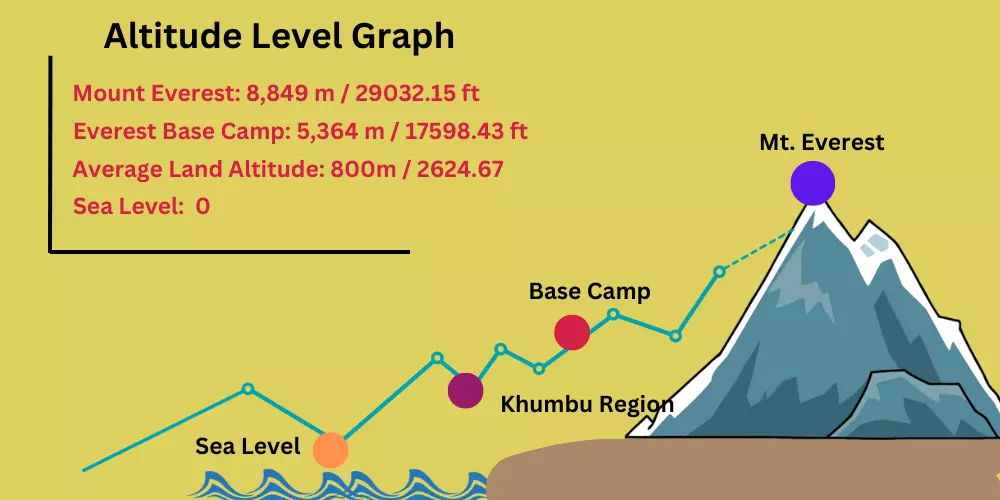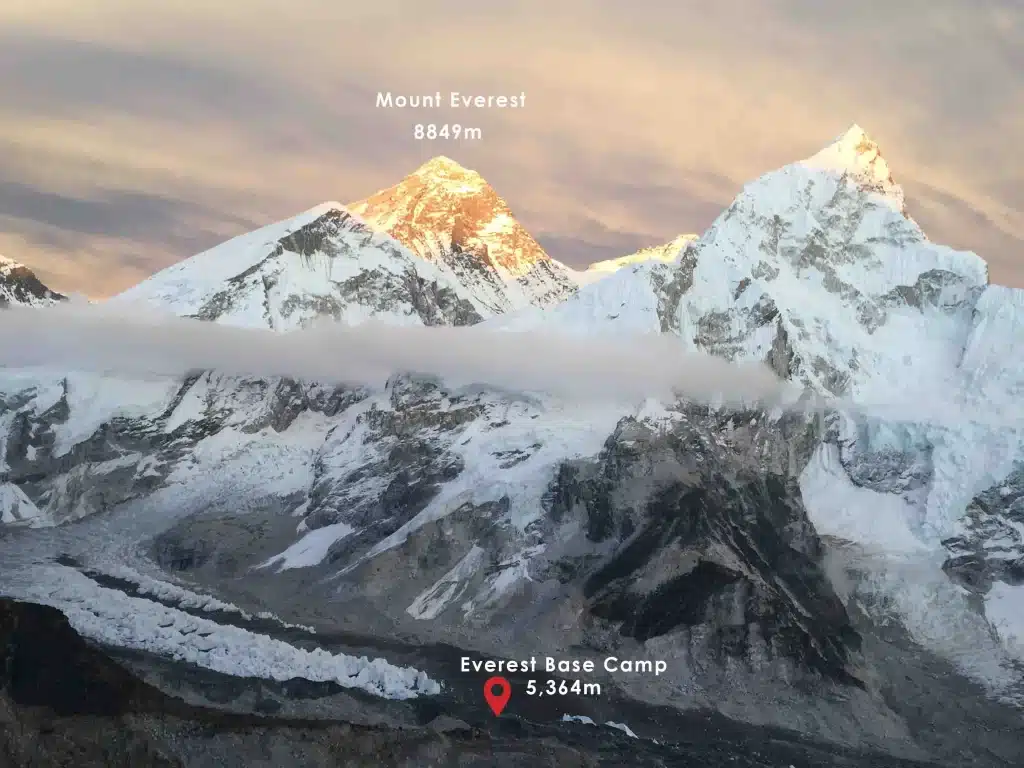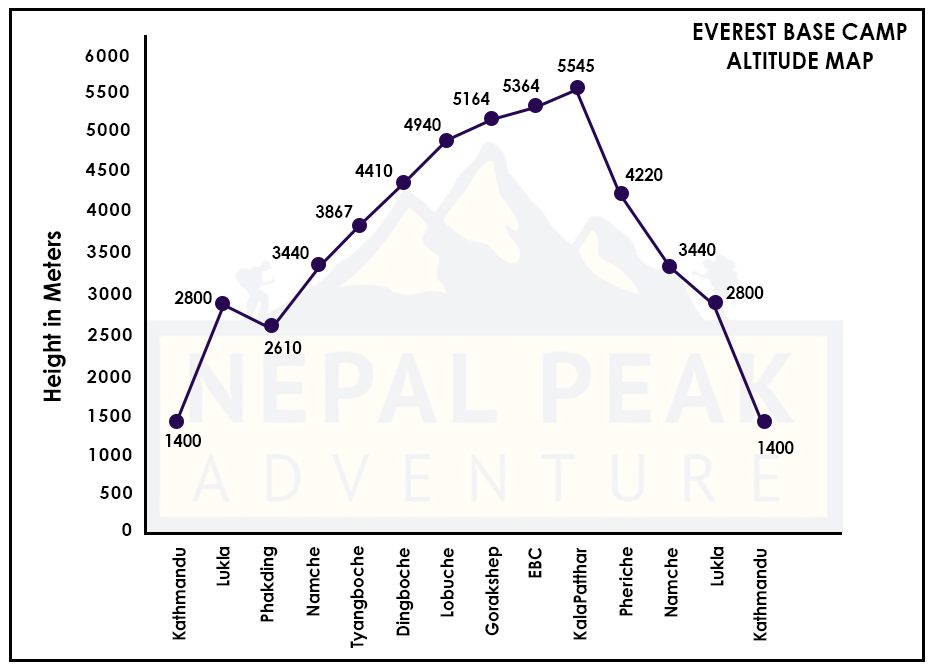Everest Base Camp Altitude: From Zero to 5,364 Meters
Nestled amidst the mighty Himalayas, Everest Base Camp is a dream destination for many adventure enthusiasts. At an altitude of 5,364m / 17,600 feet above sea level, Everest Base Camp is considered the gateway to the summit of the world’s highest peak – Mount Everest.
But what is Everest Base Camp altitude, and how hard is it to walk to the base camp? In this blog, we will explore the answers to all these questions, from its effects on the human body while trekking to the tips for managing Everest base camp altitude sickness and many more.

What is Everest Base Camp Altitude?
Everest Base Camp altitude refers to the height of Everest Base Camp above sea level where it is located. The base camp is situated in the Khumbu region of Nepal, which is at an altitude of 5,364 meters (17,598 feet).
At this exaggerated elevation, the air is thin, and the oxygen level is low, making it difficult for people to breathe and walk normally. As a result, anyone visiting the Base Camp should be aware of the base camp altitudes and their effects on their body. So proper acclimatization and preparation are essential for those undertaking treks or climbs in the region.
What is Everest Base Camp Elevation in Feet?
The elevation of Mount Everest Base Camp is approximately 17,598 feet (5,364 meters) above sea level. The base camp is the final destination of all the trekkers undertaking the Everest Base Camp treks which serves as the starting point for climbers attempting to reach the summit of Mount Everest, the world’s highest peak.
Altitude changes along the EBC trek
Embarking on the journey to Everest Base Camp involves more than just navigating challenging terrains; it’s a gradual ascent into the thin air of the Himalayas. Understanding the altitude changes along the trek is crucial for acclimatization and ensuring a safe and enjoyable experience.
A. Starting point and Gradual increase in altitude
The Everest Base Camp trek commences in the vibrant town of Lukla, located at an altitude of approximately 9,383 feet (2,860 meters) above sea level. This bustling town, with its unique airstrip that challenges even the most seasoned pilots, sets the stage for the adventure that lies ahead.
From Lukla, trekkers begin their ascent, gradually increasing in altitude as they make their way through picturesque villages, dense forests, and serene valleys. The trail meanders through Namche Bazaar, a bustling hub at 11,286 feet (3,440 meters), and continues its ascent, allowing trekkers to acclimatize to the thinning air gradually. Furthermore crossing several other settlements and overnight stays like Tyangboche 12,687 feet (3867 meters), Dingboche 14,468 feet (4410 meters), Lobuche 16,109 feet (4910 meters), and the last stop Gorakshep 16,942 feet (5164 meters) the trek concludes as you step on the altitude of Everest Base Camp 17,598 feet (5364 meters).
Remember the gradual increase in altitude is a key aspect of a successful trek. It provides the body with the opportunity to adapt to the decreasing oxygen levels, reducing the risk of altitude-related illnesses.
B. Key Altitude Checkpoints
Namche Bazaar (11,286 feet / 3,440 meters)
As the gateway to the Everest region, Namche Bazaar serves as a critical altitude checkpoint. Trekkers spend additional days here for acclimatization, exploring the local culture, and enjoying stunning views of Everest and surrounding peaks.
Dingboche (14,469 feet / 4,410 meters)
Dingboche is another pivotal altitude checkpoint, where trekkers acclimatize before reaching higher elevations. The village offers breathtaking views of Ama Dablam and provides a necessary pause in the ascent.
Lobuche (16,207 feet / 4,940 meters)
The village of Lobuche marks a significant altitude milestone on the trek. At this point, trekkers are well into the high-altitude zone, preparing for the final push to Everest Base Camp.
What is the average daily elevation gain on the trek?
The Everest Base Camp trek starts from Lukla at 2860m/9,383ft and reaches the max elevation of Kalapatthar at 5,545m/18,192ft. During this period you will gain a total elevation of +2,685 meters / 9,400 feet which is an astonishing elevation gain in just eight days. Additionally, each day you will gain an average elevation of 500m/1,640ft to 700m/2,297ft. Here are the day-to-day elevation gains:
- Lukla (2,860m) to Phakding (2,610m): -250m/820ft
- Phakding (2,610) to Namche (3,440m): +830m/2,723ft
- Namche (3,440m) to Tyangboche (3,867m): +427m/1,401ft
- Tyangboche (3,867m) to Dingboche (4,410m): +543m/1,781ft
- Dingboche (4,410) to Lobuche (4,910m): +500m/1,640ft
- Lobuche (4,910m) to Gorakshep (5,164m) to EBC (5,364m): +254m/833ft, +200m/656ft
- Gorakshep (5,164m) to Kalapatthar (5,545m): +381m/1,250ft
Understanding these key altitude checkpoints and respecting the gradual increase in elevation is essential for a safe and successful Everest Base Camp trek. It’s not just about reaching the destination; it’s about savoring every step of the journey and allowing the body to adapt to Mount Everest Base Camp heights.
Altitude challenges faced by trekkers
Trekking to Everest Base Camp is an exhilarating adventure, but it comes with its set of challenges, particularly related to altitude because the base camp is located at such a high height. And going from the sea level to the altitude of the base camp poses a great deal of risk. As trekkers ascend into the thin air of the Himalayas, understanding and addressing altitude-related issues become paramount for a safe and enjoyable experience.
A. Common Health Issues
Trekking at high altitudes exposes individuals to various health challenges, commonly referred to as altitude-related illnesses. It’s crucial for trekkers to be aware of these issues:
Acute Mountain Sickness (AMS)
AMS is a common affliction, characterized by symptoms like headaches, nausea, dizziness, and fatigue. Recognizing the signs early and taking necessary precautions, such as staying hydrated and acclimatizing properly, can mitigate the impact of AMS.
High Altitude Pulmonary Edema (HAPE)
HAPE involves the accumulation of fluid in the lungs, leading to breathing difficulties. Trekkers must be vigilant about symptoms like shortness of breath and chest tightness. Immediate descent to lower altitudes is crucial for managing HAPE.
High Altitude Cerebral Edema (HACE)
HACE is a severe condition affecting the brain, causing confusion and difficulty walking. This is a medical emergency, and trekkers should be familiar with the symptoms and prioritize immediate descent for treatment.
B. Safety Measures and Protocols
Ensuring the safety of trekkers requires a combination of preparedness and adherence to safety protocols:
Proper Acclimatization
Gradual ascent and acclimatization stops at key checkpoints, such as Namche Bazaar and Dingboche, are vital for allowing the body to adjust to increasing altitudes.
Hydration and Nutrition
Staying hydrated and maintaining proper nutrition are essential for combating the effects of altitude. Trekkers should carry an adequate supply of water and energy-rich snacks.
Monitoring Symptoms
Regularly monitoring for symptoms of altitude-related illnesses and communicating openly within trekking groups is critical. Swift action in response to symptoms can prevent the escalation of health issues.
C. Emergency Evacuation Options
Despite precautions, emergencies may arise, necessitating swift evacuation. Trekkers should be aware of available options:
Helicopter Evacuation
In cases of severe altitude sickness or injuries, helicopter evacuation is a viable option. Trekkers should have insurance that covers emergency evacuations.
Communication Devices
Carrying communication devices, such as satellite phones or emergency radios, enables trekkers to request assistance in case of emergencies.
Local Assistance
The local guides and trekking agencies are well-versed in handling altitude-related emergencies. Establishing clear communication channels with them ensures prompt response and assistance.
Effects of Altitude on the Body
Altitude affects the human body in many ways. As we ascend to higher altitudes, the air pressure decreases, and the air becomes thinner, which can cause several physiological changes. Some of these changes include:
Low Oxygen Levels: At high altitudes, the air contains less oxygen, which can lead to hypoxia – a condition in which the body doesn’t get enough oxygen. This can cause headaches, dizziness, fatigue, and shortness of breath.
Dehydration: At high altitudes, the body loses water more quickly due to increased breathing rate and sweating. This can lead to dehydration, which can cause headaches, nausea, and fatigue.
Altitude Sickness: Altitude sickness, also known as Acute Mountain Sickness (AMS), is a common problem among trekkers who travel to high altitudes. AMS occurs due to a lack of oxygen in the body, and its symptoms include headaches, nausea, dizziness, and fatigue.
Tips for Managing Altitude Sickness Everest Base Camp
Managing altitude sickness is essential for anyone trekking to Everest Base Camp. Here are some tips for managing altitude sickness:
Acclimatize Slowly: One of the best ways to prevent altitude sickness is to acclimatize slowly. This means ascending gradually, allowing the body to adjust to the altitude. Trekkers should avoid gaining more than 300-500 meters (1,000-1,600 feet) in elevation per day.
Stay Hydrated: Drinking plenty of fluids is essential to stay hydrated at high altitudes. Trekkers should aim to drink at least 3-4 liters of water per day and avoid alcohol and caffeine.
Take Medications: Certain medications can help prevent altitude sickness, such as Acetazolamide (Diamox). Trekkers should consult with their doctor before taking any medication and should only take it under medical supervision.
Recognize the Symptoms: It’s crucial to recognize the symptoms of altitude sickness and take action if necessary. Trekkers should inform their guide or travel partner if they experience any symptoms of AMS.
Hence, trekking to Everest Base Camp is not an easy feat and requires proper planning and preparation to avoid altitude sickness and other health hazards. The trek can take anywhere between 10-15 days, depending on the route and itinerary chosen.
Note: You can read our 12-day standard itinerary blog from Lukla to Everest Base Camp.

How hard is it to walk to Everest Base Camp?
Trekking to Everest Base Camp is a challenging experience, and it is important to be in good physical shape before embarking on the journey. The trek involves long hours of walking through rugged terrain, steep ascents and descents, and high-altitude passes. Moreover, the weather conditions can be harsh, with extreme cold, wind, and snow.
One of the biggest challenges of trekking to Everest Base Camp is the risk of altitude sickness. As the altitude increases, the oxygen levels in the air decrease, making it difficult for the body to adapt. This can result in symptoms such as headaches, dizziness, nausea, and shortness of breath. Therefore, it is crucial to acclimatize properly during the trek and take necessary precautions to avoid altitude sickness.
Despite the challenges, trekking to Everest Base Camp is a rewarding experience, and the breathtaking views of the Himalayan peaks make it all worthwhile. The trek offers a chance to explore the unique culture and traditions of the Sherpa community and witness the natural beauty of the Khumbu region.
Is Everest Base Camp higher than Kilimanjaro?
Mount Everest and Mount Kilimanjaro are two of the most popular trekking destinations in the world. While Everest Base Camp is the base camp for Mount Everest, Kilimanjaro is a standalone peak located in Tanzania, Africa. Therefore, it is not possible to compare the altitude of Everest Base Camp with that of Kilimanjaro.
However, it is worth noting that the summit of Mount Everest is much higher than the summit of Mount Kilimanjaro. Mount Everest stands at an elevation of 29,029 feet or 8,848 meters, while Mount Kilimanjaro stands at an elevation of 19,341 feet or 5,895 meters. Trekking to the summit of either peak requires proper planning, preparation, and a high level of fitness.
Everest Base Camp Altitude Map

Conclusion:
Trekking to Everest Base Camp is a challenging yet once-in-a-lifetime rewarding experience. With proper planning and preparation, anyone can embark on this adventure and witness the natural beauty of the Khumbu region.
Don’t allow the altitude of Everest Base Camp to dampen your spirits and confidence. Despite the challenging elevation and the difficulty of the trek, the journey is undeniably worth experiencing at least once in a lifetime. Prepare yourself, conquer any apprehensions about the height of Everest Base Camp, and set forth on this legendary trek that promises a lifetime of memories.
If you have any queries regarding the Everest Base Camp Altitude and Everest Base Camp Trek then please feel free to connect with us here.



